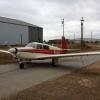NTSB Identification: WPR17LA212
14 CFR Part 91: General Aviation
Accident occurred Friday, September 22, 2017 in Glendale, CA
Probable Cause Approval Date: 11/15/2018
Aircraft: MOONEY M20E, registration: N34BE
Injuries: 2 Minor.
NTSB investigators may have traveled in support of this investigation and used data provided by various sources to prepare this aircraft accident report.
The private pilot and passenger had planned a round trip personal flight in the pilot’s single-engine airplane. According to the pilot, he had wanted to service the airplane with fuel before the return leg, but he did not do so due to the passenger’s desire to arrive home before a certain time. During the initial descent of the return leg, the engine lost total power. The pilot conducted a series of troubleshooting steps to no avail and then conducted a forced landing onto a residential street and struck trees. Postaccident wreckage examination revealed that both fuel tanks were empty, and although the right fuel tank sustained a small breach during impact, there was no fuel odor at the accident site. A series of brown streaks were observed trailing from an area adjacent to the right-wing fuel sump drain. The sump valve sealant was badly degraded, and it is possible that a small fuel leak had developed at an undetermined time; however, blue streaking would have been more likely if a significant and recent fuel loss had occurred. Further examination revealed no leaks in the fuel supply system or engine. The engine tachometer was tested for accuracy, and no anomalies were noted. During an engine test run, the engine started normally and operated through its full speed range with no evidence of a mechanical anomaly.The pilot had purchased the airplane 5 months before the accident and had been tracking fuel consumption since his purchase. He determined a representative fuel burn rate based on fuel purchases and engine tachometer hour-meter readings. The pilot reported that he did this because the fuel gauges were unreliable, and he did not possess a calibrated dipstick to measure the actual fuel quantities. Using his calculated fuel burn and tachometer reading method, the pilot estimated that he had enough fuel remaining to complete the flight and land with the Federal Aviation Administration-required 45-minute fuel reserve. However, he had performed multiple flights since the last fill up, which included one go-around and a full runway-length taxi earlier in the day. The total time for those flights was near the airplane’s fuel endurance limit when measured by tachometer time, but the fuel consumption was likely higher due to the increased consumption demanded by the engine during the multiple takeoffs. It is likely that the pilot miscalculated the amount of fuel on board before the flight, which resulted in fuel exhaustion and a subsequent total loss of engine power.
The National Transportation Safety Board determines the probable cause(s) of this accident as follows:
The pilot’s inadequate preflight fuel planning and improper decision to not refuel before the flight, which resulted in fuel exhaustion and the subsequent total loss of engine power.






